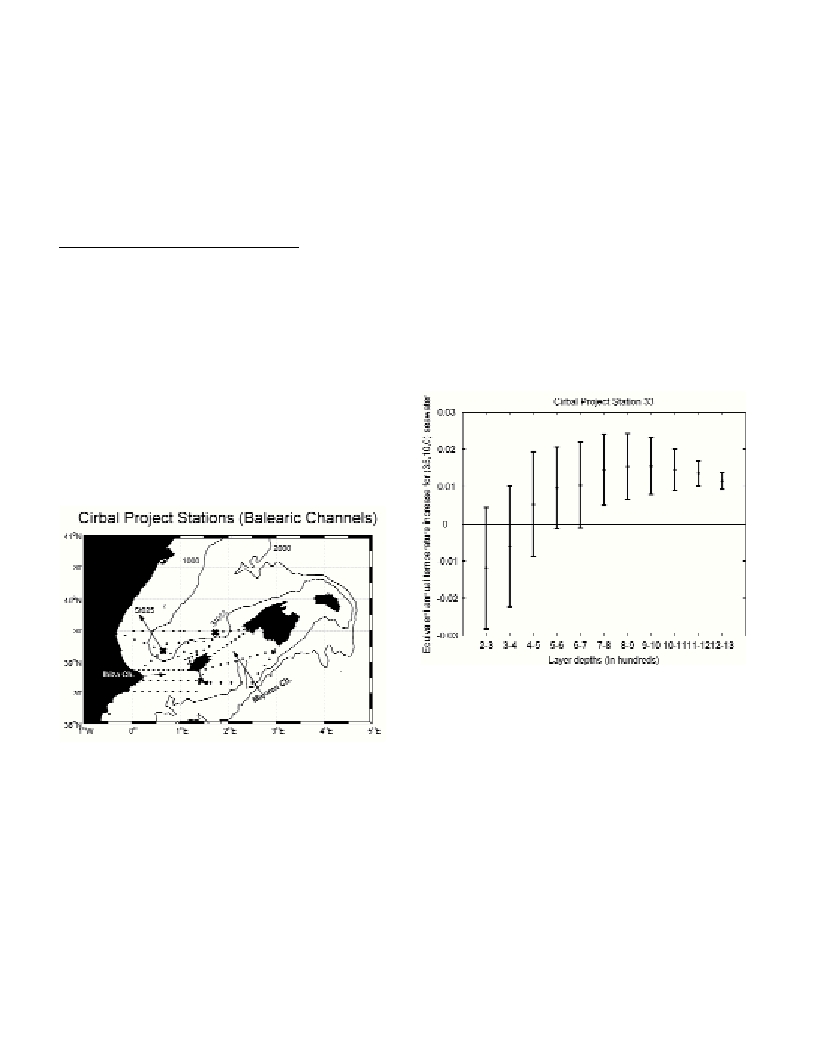Rapp. Comm. int. Mer Médit., 37,2004
103
PROGRESSIVE WARMING OF THE WESTERN MEDITERRANEAN DEEP WATER
AT THE BALEARIC AREA SINCE MID NINETIES.
González-Pola C.
1
*, López-Jurado J.
2
, Vélez-Belchi P.
3
1
Instituto Español de Oceanografía, C.O. de Gijón, Avda. Príncipe de Asturias 70 bis, 33212 Gijón, Spain - * cesar.pola@gi.ieo.es
2
Instituto Español de Oceanografía, C.O. de Baleares, Muelle de Poniente s/n, 07080 Palma de Mallorca, Spain - lopez.jurado@ba.ieo.es
3
Instituto Español de Oceanografía, C.O. de Canarias, Crta. de San Andrés 45 s/n, Tenerife, Spain - pedro.velez@ca.ieo.es
Abstract
The interanual variability of the heat stored on intermediate and deep water at the Balearic Sea is analyzed from two deep hydrographic
stations repeated frequently from year 1996. A statistically significant warming trend, equivalent to approximately 0.015 ºC per year, has
been found below the 700 db in both stations. Thickness of DW (Deep Water) layer as classically defined at the area has been dramatically
reduced whereas the LIW (Levantine Intermediate Waters) layer has increased.
Keywords: heat content, warming, Balearic Sea
The accumulation of evidences in favour of an anthropogenic
induced climate change scenario have increased in the last decades the
interest on the behaviour of long term properties of intermediate and
deep water around the oceans of the world. All data available for the
whole ocean shows a warming of 0.03 ºC for the 300 m depth upper
layer during the previous century [1]. Some studies regarding the
Mediterranean Sea have also found warming and salinity increase for
deep and intermediate waters [2], [3].
In this paper we will explore the recent changes on heat content of
the central and deep waters at the Balearic Sea from a series of
hydrographic cruises repeated almost once a year in the period
between 1996 and 2003. The base of this work is the data set from the
“Canales” and “Cirbal” projects (Instituto Español de Oceanografía)
[4]. Under those projects several transects were reoccupied in
different seasons (Fig.1). Deep hydrographic stations 25 and 33,
located on the northern entrance of both the Ibiza and Majorca
channels have been sampled more than 10 times for the whole water
column, their respective depths are 1250 and 1360 m.
Fig. 1. Stations for the “Canales” and “Cirbales” Projects (1996-2003)
at the Balearic Channels. The two chosen for this work are marked.
Water masses at the Mediterranean Sea are characterized by the no
existence of permanent thermocline which maintains a stratified
situation controlled by density. This particular feature makes
impossible to use isopycnal levels to define water masses so
??
/
?
s
bounded regions are used instead. Below the upper mixing layer at the
studying area we find the seasonal Winter Intermediate Water (WIW,
[12.5-13.0 37.9-38.3])[4], Levantine Intermediate Water (LIW, [13.0-
13.5 38.4-38.55]) and Deep Water (DW, [12.70-12.90 38.4-38.50]).
The mean depth of the core of LIW, from an averaged profile for the
whole data set, is located around 500 db and the top level of DW
waters as previously defined is around 1100 db.
A noticeable warming of the water column is observed from the
data. Levantine Intermediate Water (LIW) shows yearly dependence
on the climatic atmospheric forcing and higher values of temperature
and salinity appeared on year 1998 coinciding within the warmest
year ever recorded on the north Atlantic. Both DW and the transition
branch from the LIW have experimented a progressive warming
which resulted in a reduction of the thickness of DW, as previously
defined, from more than 300 db (years 96 and 97) to around 100 db
(year 2003). A linear fit of the evolution of heat content stored by 100
db thickness layers gives positive trend at 95% confidence intervals
for all depths below 700 db (station 33 on Figure 2 and similar result
for station 25). The mean value from 700 db to the bottom is 58 ±25
kJ/m
3
year heat increase (which would result on 0.014 ±0.006 ºC/year
if applied on standard (s=35,
?
=10,p=0) seawater). Confidence
intervals reduces with depth showing a lesser noisy warming signal
(better linear fitting) as we approach to the bottom layer.
Fig. 2. Trend found for a linear fitting of the evolution of the heat stored
between isobaric layers, showed as a temperature equivalent if applied
on (s=35,
?
=10,p=0) seawater, for the time series at station 33.
Confidence interval 95%.
References
1-Levitus S., Antonov J.I., Boyer T.P., and Stephens C., 2000. Warming
of the world ocean. Science, 287: 2225-2229.
2-Bethoux J.P., Gentili B., Raunet J. and Tailliez D., 1990. Warming
trend in the western Mediterranean deep water. Nature, 347: 660-662.
3-Rohling E.J. and Bryden H.L., 1992. Man-induced salinity and
temperature increases in Western Mediterranean Deep Water. Journal of
Geophysical Research. C. Oceans, 97: 11191-11198.
4-Pinot J.M., Lopez-Jurado J.L. and Riera M., 2002. The CANALES
experiment (1996-1998). Interannual, seasonal, and mesoscale variability
of the circulation in the Balearic Channels. Progress in Oceanography,55:
335-370.

